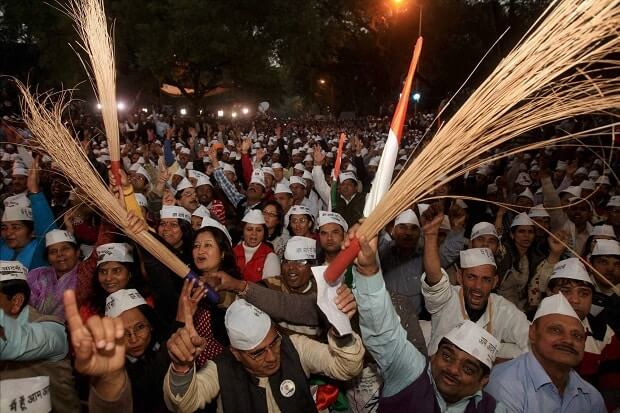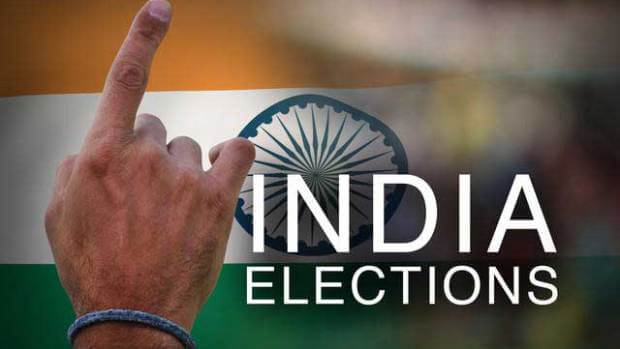Each of the three main players representing their party have a unique method of addressing their audience, reports PRASHANT SOOD

They are the lead campaigners of parties contesting over 400 Lok Sabha seats and are slugging it out in the heat and dust of elections. Narendra Modi, Rahul Gandhi and Arvind Kejriwal have campaign styles driven by their different persona and vision for the country and seek to connect in their own way with the masses.
Modi (63) and Gandhi (43) also represent a generational change in their parties. Kejriwal, 45, is the new and spirited challenger, keen to change the established political order.
Modi is the prime ministerial candidate of the Bharatiya Janata Party (BJP). Gandhi is leading the campaign of the Congress and Kejriwal is the main campaigner of the Aam Aadmi Party (AAP).
Modi has embarked on a planned and well-publicised campaign and is expected to some 185 “Bharat Vijay” rallies before campaigning for the Lok Sabha polls ends in May. Modi has garnered so much media attention, that BJP’s national campaign effectively centres around him.
Congress sources said Rahul Gandhi is expected to address about 80 more rallies over May and Congress president Sonia Gandhi is also slated to address rallies across states.
Kejriwal, who is pitted against Modi in Varanasi, has been reaching out to people through road shows and rallies in different states.
AAP sources said that Kejriwal will focus on Varnasi in the coming days.
Modi likes to engage with the audience during his speeches and laces his remarks with sarcasm. He poses questions and then seeks replies from the gathering. Modi raises local issues to build enthusiasm among people, some of whom resort to sloganeering in his favour.
Unsparing in his attacks, Modi almost ritualistically takes digs at the Nehru-Gandhi family. A natural speaker who appears at ease, Modi delivers his punches hard. He speaks at an easy pace and tries to use expressions that can create headlines.
In his rallies in Haryana and Rajasthan, Modi made jibes at Congress over the alleged land deals of Sonia Gandhi’s son-in-law Robert Vadra. He refers to Rahul Gandhi as ‘shehzada’ (prince) and to the Congress as the ‘sultanate’ (Mughal kingdom).
Modi uses Hindi adages to sharpen his attack and speaks on an array of issues including price rise, defence, women’s security and education. Modi has sought to identify himself with the expectations of aspiring classes and presents himself as a strong alternative to the perceived discontent among people with the Congress-led United Progressive Alliance government on issues of price rise, corruption and “policy paralysis”.
Rahul Gandhi’s speeches have been increasingly targeted towards Modi, portraying him as a know-all, dictatorial leader with a communal mindset.
Gandhi looks less grim than his BJP rival and delivers his speeches in a less serious and sarcastic tone. He talks about entitlements brought about by the Congress in the last 10 years and seeks to identify the party with the poor, the youth and the middle classes.
Gandhi presents himself as a leader who likes to work by consultation and consensus, who values the opinion of others and wants to sort out problems through the process of accommodation. Gandhi appears keen to look informal, accessible and approachable. In some of his rallies he has dressed in jeans and a kurta – a sartorial combination popular across college and university campuses.
Gandhi’s speeches can appear repetitive to those who follow him closely.
In his rallies, Gandhi has targeted Modi over the Gujarat model of development and snoopgate and the BJP over “divisive politics”. He has also sought to present Congress as a unifying force whose heart is with the poor and which is keen to expand opportunities for every Indian.
Kejriwal speaks and dresses in the manner of the common man. Normally clad in a shirt and trouser, Kejriwal’s delivery style is simple, direct and forthright. He seeks to avoid rhetorical flourishes and speaks like a man who does not want to indulge in the politics of compromise.
Kejriwal does not move with heavy security and associated paraphernalia. Kejriwal speaks with confidence and seeks to link success and failure of his party with that of common man. He gives the impression of a leader detached from the privileges and perks of high office with a keen desire to end the problems of the people.
Battling allegations of being a “quitter” after his AAP government resigned in less than two months of assuming power after the Delhi assembly elections, Kejriwal presents himself as a leader prepared to make any sacrifice for his principles.
His attacks on the Congress and BJP for their alleged cosiness with the corporates and his strong anti-corruption plank appears to have struck a chord with people.
AAP is perhaps the only party in the country which has put up candidates on over 400 Lok Sabha seats in less than two years of its formation and looks poised to achieve status of a national party.
Political analysts said that Modi, Gandhi and Kejriwal were trying to be strident in their own ways.
Senior journalist BG Verghese said that people coming for rallies do not necessarily vote for the same party.
“Each of them has his own style. Modi is asking votes for himself and is very strident in his stance and so is Rahul and Kejriwal. They also repeat themselves,” Verghese said.
He said the BJP has launched a concerted advertisement campaign and questions would be raised about the money involved.
Subrata Mukherjee, a political analyst who taught at Delhi University, said Modi was the most impressive of the three leaders as “he has the punch”. “He also answers charges levelled against him. He has developed the Gujarat model and has something to show which others do not. He carefully picks on the weak points of his opponents,” stated Mukherjee.

Hundreds of thousands vote in India’s fifth phase of polls
At the time of going to press, hundreds of thousands cast their vote in four states in the fifth phase of elections, marking the halfway mark in India’s 10-phase staggered polling. Till now, over 170 million people have cast their vote across the country in 111 constituencies to choose from more than 1,500 candidates in the elections that began April 7 and will end May 12. Counting takes place May 16.
Balloting recently took place in three constituencies of Assam, two seats of Goa, Tripura’s second Lok Sabha constituency and Sikkim’s lone parliamentary constituency. The voter turnout was high in all the four states recording a 70-80 percent turnout, and polling was largely peaceful.
In Tripura, long queues of men and women voters, including tribals, were seen in most of the 1,490 polling stations. Six of them are all-women polling stations manned by women polling personnel only.
In picturesque, yet sparsely populated Sikkim, a good number of the 362,326-member electorate turned up to vote at most of 538 polling stations.
In Assam, brisk balloting was recorded in Silchar, Karimganj and Diphu (Autonomous District). Of the 2,926,762 eligible voters in the three constituencies, 1,400,594 are women.
April 10 was a critical day as millions voted across 14 states and union territories in the third round of parliamentary elections to pick 91 of the country’s 543 MPs. An estimated quarter of the 191 million electorate had voted by noon in five hours of balloting, with long queues of men and women seen right from the time the polling centres opened at 7am in the morning. Voter enthusiasm was high in both working class and middle class areas, and was mostly peaceful.
Chief Election Commissioner VS Sampath hoped that voting percentage would keep improving with every round of the Lok Sabha election.
There was a record voter turnout of 73.4 percent in Kerala, where balloting took place for all its 20 parliamentary constituencies.

A cross-section of voters
The ECI made arrangements to have wheelchairs at every polling station in Delhi, a blessing for senior citizens who turned up enthusiastically to vote. There are around 324 voters in Delhi aged above 100 years. Besides the century-plus voters, Delhi also has 10,104 senior voters between the age of 90 and 100.
Delhi’s disabled too, cast a smooth, hurdle-free vote with polling stations equipped with wheelchairs, Braille sheets and designated volunteers for assistance. The efforts made Delhi’s differently-abled community hail the provisions made by the Election Commission as pleasant ones. Calling the overall experience “wonderful,” Disability Rights Group convener Javed Abidi said that it was not only the facilities, the staff deployed at the booths were courteous too. Delhi has over 80,000 disabled voters, including visually challenged and hearing impaired.
Even sex workers living in Delhi’s infamous GB Road red-light area came out in good numbers to cast their vote and were extremely happy to have equal power and representation in the formation of the new government. Coming in groups of friends and families, these women headed towards a polling booth in Chandni Chowk’s Ajmeri Gate area. “I am very excited to exercise my vote for the first time in the Lok Sabha polls, and I can proudly say that I am an Indian citizen,” said Poornima, 23, a sex worker. “This is one day when people don’t discriminate us. We are in the same queue as others, waiting for our turn to push the button,” she added. According to Iqbal Ahmad, general secretary of NGO Bhartiya Patita Uddhar Sabha (BPUS) that works for the sex workers, over 1,800 sex workers had enrolled as voters.
In total, Delhi recorded its highest voter turnout in the last three decades with 64.77 percent polling.
In conclusion, it was largely a cleaner, more orderly and more efficient election. The Election Commission of India, learning from experiences of past elections, keeps improving and innovating so that each election becomes better than the previous one.
There were fewer complaints of missing voters or lack of facilities or unhelpfulness of poll staff and police. And with the city catering to an electorate of over 12 million, this was no ordinary feat.
However, not everyone voted for political parties. The None Of The Above (NOTA) button was sought after by a significant number of people. It should make an interesting statistic when the election results are posted.
Selfies with their inked finger have been making the rounds of social media sites, as people show proof of exercising their democratic right while asked others to vote too. Among these are cricketer Suresh Raina who posted his selfie with the inked finger in focus, and the message: “I have done my vote, have you?”, on Twitter. Pictures of inked finger, with accompanying messages like “my vote, my pride,” “best thing I have done as an Indian citizen” have been posted on social networking sites like Twitter and Facebook. Emoticons (animated expressions) were a substitute to reflect their various moods of happiness after casting the ballot. There were many who posted only their inked finger, and not the selfie!

Delegation from 19 countries witness Delhi polls
A 30-member delegation from 19 countries, including many from Africa visited some polling stations in the nation capital to observe the Indian democracy at work, said a senior poll panel official in New Delhi. The delegation included representatives from Bhutan, Sri Lanka, Congo, Ethiopia, Ghana and Lebanon.
“The representatives were also briefed about the elaborate arrangements made by the Election Commission to make the elections successful. They saw the voting process and the security arrangements made to ensure fair and safe elections,” the official said.
The official added that the delegation was also informed about the special arrangements that were undertaken this time for the disabled to ensure that they don’t face any problems when they vote.
The Election Commission of India (ECI) and UNDP have a memorandum to jointly promote exchange of visits and sharing of experiences and skills in the field of electoral management with developing countries.
And members of the delegation were highly impressed by the smooth conduct of polls and say India has become a learning centre for other developing countries. The sheer scale of the Indian general election has left them marvelling.
“We visited a model polling station in Delhi and witnessing the magnificent arrangements for voters. It also shows that polls of such magnitude can be conducted in such a smooth manner. This would help the other developing countries too,” said Abednego Akok, Chief Election Commissioner of South Sudan.
Said Akok, “India has become a learning center for developing countries of the world. Despite being the world’s largest democracy and being prone to hassles like population, problems due to a multi-party system and frequent violation of the model code of conduct by political parties, the Election Commission of India is able to conduct polls in a very smooth manner”.
Akok is part of the 30-member delegation from 19 countries that visited polling stations in other states as well as the national capital. Besides Akok, the delegation includes senior election officials from Ghana, Kyrgyzstan, Lebanon, Malaysia, Maldives, the Philippines, Sierra Leone, Sri Lanka and a few other developing countries.
Rigzen Lhundrup, a senior election official from Bhutan, said, “The best thing about the poll process in India is the systematic way it is conducted despite India being the second most populated country in the world”.
“India can be a role model for the developing nations and we can learn a lot about how to conduct the polls in a smooth and fair manner. India’s role has been magnificent in conducting the polls in Bhutan in a fair and smooth manner,” Lhundrup stated.
Complied from news reports on IANS






